

The first flying time of the day, the number of pilots on the aircraft, the number of legs on the flight, and the sort of rest facilities available on the plane all influence flight duty constraints. Activities such as standing by at the airport, training, and going as a passenger to take over a flight at a different airport constitute flight duty unless the pilot has a rest break that meets FAA guidelines. The limit can be increased to 13 hours if there are three pilots on the trip, and to 17 hours if there are four pilots.įlight duty begins when a pilot reports for duty with the expectation of conducting a flight and ends after he has parked the plane on which he flew his last flight. The maximum flight time is eight hours if the first flight departs at any other time. If there is just one pilot on the trip, the maximum flying time is nine hours if the pilot’s first flight of the day begins between 5 a.m. This includes not just the flight time, but also duties like taxiing, deicing, and waiting time if the engines are turned on. Hours: 75-100 flight hours and 150 ground hours /month.įlight time is defined by the FAA as the amount of time the plane is powered up and moving. Many people will be away from home for several days on long-haul and/or overnight flights. A second officer or flight engineer may be required on some long-haul flights to monitor systems and relieve the other pilots. A flight crew normally consists of a captain, who serves as a pilot in command and has final authority over the flight, and a co-pilot or first officer. Hours: 80-100 flight hours and 100 ground hours /monthĪirline Transport Pilot An airline transport pilot is employed for a company that transports passengers and freight regularly.

They may also use flight training devices or simulations to train pilots on the ground. When they are not logging flight hours, they construct particular lesson plans and follow the curriculum for ground training courses.
PART TIME PILOT HOURS HOW TO
A duty day can be more than 14 hours, including pre-and post-flight operations as well as actual flying time, especially if there are weather delays.įlight Instructor Student pilots are taught how to operate an airplane, grasp flying concepts, inspect safety features and flight equipment, and safely take off and land the plane by flight instructors. To ensure that each flight is performed to the highest level of safety, pilots are responsible for various time-consuming tasks before and after a flight, including weather assessments, completing flight plans, executing pre-flight checks on aircraft, and filing post-flight reports. However, actual flight time does not represent the number of hours a pilot can be on duty. “Stick time” refers to the time when they are really at the controls during the flight. In a month, one of our member pilots may fly an aircraft for up to 118 hours. The time a pilot spends “on the job” does not just refer to the time he or she spends operating an aircraft on the flight deck. Long-haul pilots, for example, work longer hours but have longer amounts of time off between workdays than short-haul pilots. Depending on the length of the flight, the pilot is impacted by flight time constraints. Short-Distance FlightsĪ short-haul trip is 30 minutes to 3 hours long, a mid-haul flight is 3 to 6 hours long, a long-haul flight is 6 to 12 hours long, and an ultra-long-haul flight is 12 hours or more long. To begin, you must understand the differences between short and long trips, as well as the differences between flight and duty times.


 0 kommentar(er)
0 kommentar(er)
